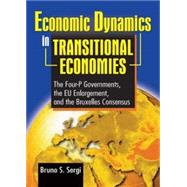
Note: Supplemental materials are not guaranteed with Rental or Used book purchases.
Purchase Benefits
What is included with this book?
| Foreword | ix | ||||
|
|||||
| Preface | xiii | ||||
|
|||||
| Acknowledgments | xv | ||||
| Abbreviations and Acronyms | xvii | ||||
| Introduction | 1 | (8) | |||
|
2 | (1) | |||
|
3 | (1) | |||
|
4 | (1) | |||
|
5 | (4) | |||
| Chapter 1. The Political Economy in Europe: The Three-P Governments | 9 | (50) | |||
|
9 | (2) | |||
|
11 | (3) | |||
|
14 | (7) | |||
|
21 | (5) | |||
|
26 | (20) | |||
|
46 | (13) | |||
| Chapter 2. Accepting a Challenge: Joining the Western European Club | 59 | (34) | |||
|
59 | (4) | |||
|
63 | (2) | |||
|
65 | (8) | |||
|
73 | (10) | |||
|
83 | (6) | |||
|
89 | (4) | |||
| Chapter 3. Developments in Transition Economies: Syndromes and Structural Breaks | 93 | (44) | |||
|
93 | (3) | |||
|
96 | (4) | |||
|
100 | (7) | |||
|
107 | (7) | |||
|
114 | (6) | |||
|
120 | (14) | |||
|
134 | (3) | |||
| Chapter 4. The Political Economy of Keynes, Schumpeter, and the Supply-Siders | 137 | (26) | |||
|
137 | (6) | |||
|
143 | (4) | |||
|
147 | (7) | |||
|
154 | (6) | |||
|
160 | (3) | |||
| Chapter 5. The Bruxelles Consensus and the Fourth-P Government | 163 | (18) | |||
|
163 | (1) | |||
|
163 | (6) | |||
|
169 | (4) | |||
|
173 | (5) | |||
|
178 | (7) | |||
|
185 | ||||
| Appendix. Relevant Internet Addresses: Widening the EU's Boundaries | 181 | (14) | |||
| Notes | 195 | (4) | |||
| References | 199 | (24) | |||
| Index | 223 |
The New copy of this book will include any supplemental materials advertised. Please check the title of the book to determine if it should include any access cards, study guides, lab manuals, CDs, etc.
The Used, Rental and eBook copies of this book are not guaranteed to include any supplemental materials. Typically, only the book itself is included. This is true even if the title states it includes any access cards, study guides, lab manuals, CDs, etc.